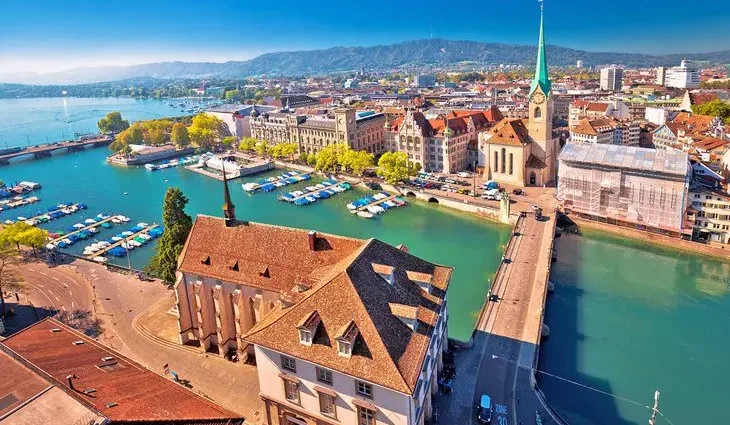Contents
Alpine flowering valleys, breathtaking mountain views, and some of the bluest lakes in Europe are just a few of the reasons to visit Switzerland. This small country in the heart of Europe is also a cultural destination, with busy cities like Zurich and Geneva offering plenty of cosmopolitan fun, and others like Bern and Lucerne packing in the outdoor beauty.
Whether you’re here in winter or summer, Switzerland won’t disappoint. Colder months bring amazing skiing and some of the best Christmas markets in Europe. In summer, lakeside cities and never-ending hiking trails open up doors for adventure.
We’ve picked some of the best places to visit to give you a head start in discovering this stunning country. Plan your trip with our list of the top cities in Switzerland.
1. Zurich
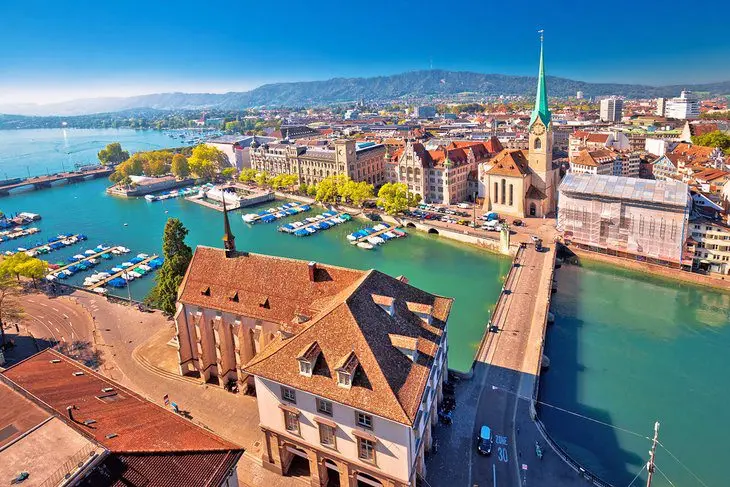
Zurich is the financial capital of Switzerland, famous for its luxurious shopping, dining, and entertainment. If you can deal with the sticker shock, this is the best city in Switzerland to buy designer brands and unique boutique items.
The best of the best is on Bahnhofstrasse, a one-mile-long high-end shopping street, but smaller shops and antique stores around the city offer other options as well.
Home to 50 museums and over 100 art galleries, Zurich offers plenty to keep you busy. Switzerland’s most visited museum, the Swiss National Museum, is in Zurich. So are Cabaret Voltaire, the birthplace of Dadaism, and the Uhrenmuseum Beyer, a museum dedicated to timekeeping and home to some of the world’s oldest clocks.
For outdoor summer fun, make the most of Lake Zurich by renting a canoe, taking a sunset cruise, or jumping in for a dip. The shores of the lake offer biking trails, great dining, and breathtaking views.
2. Geneva

Geneva is Switzerland’s most multicultural city, thanks in part to it being home to the headquarters of the United Nations. This melting pot of cultures has resulted in great international restaurants and very unique attractions to visit.
Science geeks will find plenty of things to do in Geneva, starting with a visit to CERN (European Organization for Nuclear Research) and its groundbreaking research on the “God particle.” Then there’s also Geneva’s observatory, responsible for assessing the accuracy of Swiss timepieces. And if timekeeping is your thing, Geneva is also home to the Patek Philippe Museum, the world-famous luxury watch manufacturer.
Other great stops are the International Red Cross and Red Crescent Museum, and the International Museum of the Reformation. And don’t forget to take a walk around the Old Town, home to cobblestone streets lined with adorable boutique shops, the St. Pierre Cathedral, and plenty of charming cafés.
Like Zurich, Geneva is famous for its lake, one of the largest freshwater lakes in Europe. A stroll by the lake is a must when visiting to admire the crystal-clear waters and see the giant Jet d’Eau water jet shoot water 140 meters into the air.
3. Lucerne
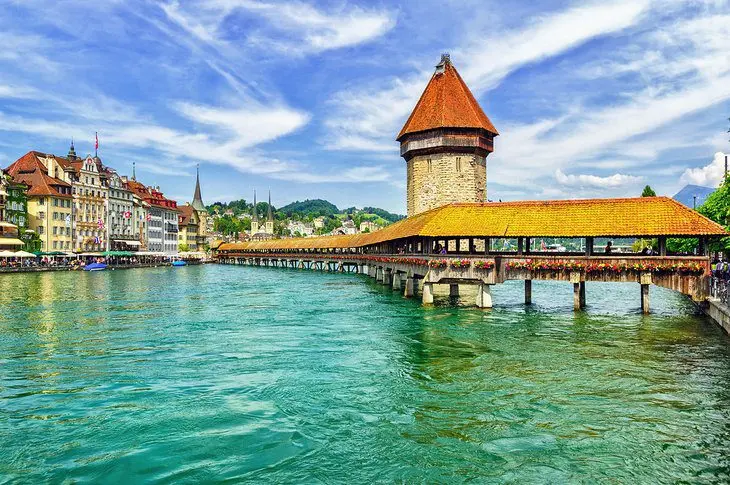
Lake Lucerne is perhaps more famous than the city that shares its name, and with good reason. It’s home to Kapellbrücke, the world’s oldest covered wooden bridge, as well as to old steamers and paddleboats that ply the blue-green waters. Lucerne’s Old Town and the Museggmauer (remnants of the old towers and fortified walls that once surrounded the city) are great places to explore and discover as you walk around.
Lucerne is particularly beautiful in winter. Ski resorts surround the city, charming Christmas markets take over the streets, and the Lucerne Carnival (in February) transforms Lucerne into a fantastical celebration of giant masks and floating mythical figures.
Nearby Mount Pilatus offers snow tobogganing in winter and stunning views over Lucerne all year long – and the top can be easily reached using a cable car.
4. Winterthur
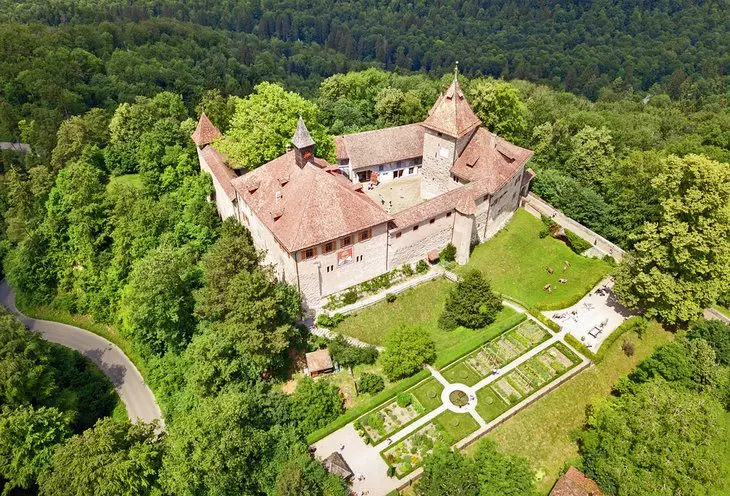
Located just 20 kilometers from Zurich, Winterthur might be a large city of over 100,000 residents but it feels like a small town. This is even more clear in the Old Town, where the narrow cobblestone streets zigzag around the centuries-old buildings that make up Marktgasse shopping street.
Perched up on a hill above the Töss River, Kyburg Castle is another remnant of centuries gone by. The castle tours are a must-do, as they take visitors down into the dungeons, through the medieval kitchen, and into the castle’s armory and chapel.
Winterthur is home to several museums, including the hands-on science museum Technorama and the Fotomuseum Winterthur, dedicated to the work of world-renowned photographers like Paul Graham and Robert Frank.
For art enthusiasts, the city is home to two museums dedicated to the collections of local art patron Oskar Reinhart, who owned everything from Monet, van Gogh, and Cézanne works to more modern art.
Accommodation: Where to Stay in Winterthur
5. Basel
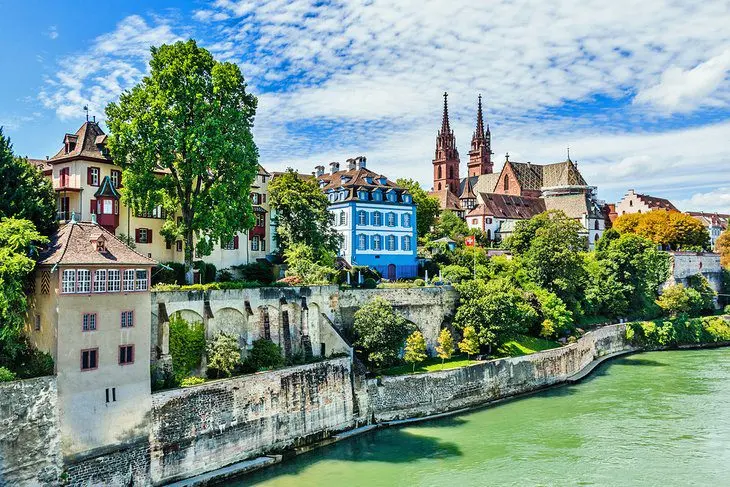
Basel is nestled right on the Rhine river and enjoys over 300 days of sunshine every year – a perfect combination that invites visitors to canoe down the river, try a dinner cruise, or jump into the clear waters for a swim.
During the warmer months, the riverbank is a popular gathering spot, whether that means sitting down on the grass for a picnic or enjoying one of the many cafés and restaurants that look over the water.
Basel is known as Switzerland’s most artsy city, and its top attractions include more than 40 museums. In addition to major museums such as the Kunstmuseum (Museum of Fine Arts) and the Natural History Museum, Basel also hosts several quirky collections. Stop by the Spielzeug Welten Museum, a toy museum with a large collection of teddy bears, then head on over to Switzerland’s only cartoon museum.
If science is more your thing, you can visit the Pharmazie-Hostorisches Museum (Museum of Pharmacy), set in what once was the home of a famous alchemist.
Basel’s Basler Fascnacht is the biggest carnival celebration in Switzerland. It lasts for three days in February and offers plenty of colorful parades, food stalls, and masked musicians.
6. La Chaux-de-Fonds
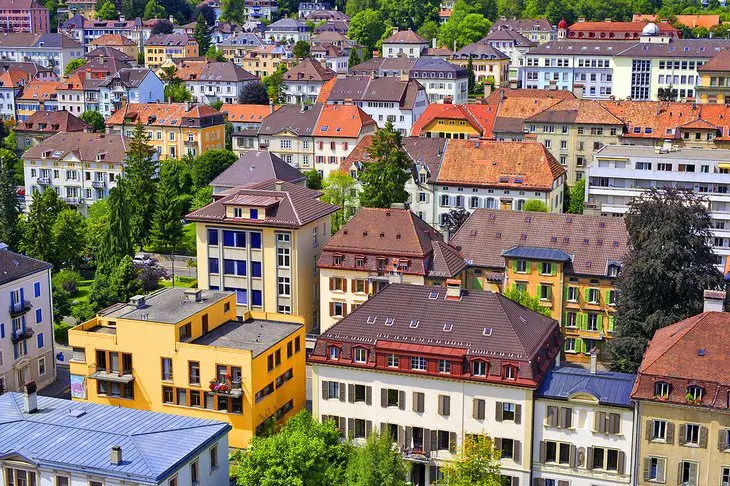
Sitting at an altitude of 1,000 meters, La Chaux-de-Fonds is Switzerland’s highest city. Surrounded by valleys, open countryside, and the beautiful river Doubs on the French-Swiss border, the city is a great starting point for hikes.
La Chaux-de-Fonds also has a close connection to architecture. Modern architect Le Corbusier was born here, and the city is a striking display of Bauhaus and Art Nouveau structures mixing in with steep streets that seem out of another century. An impressive 23 buildings in the city have been declared Swiss heritage sites of national significance, including the Bibliothèque de la Ville de la Chaux-de-Fonds and the Museum of Natural History.
The heart of the watch-making industry in Switzerland, La Chaux-de-Fonds hosts the International Museum of Watchmaking, chronicling the history of timekeeping with over 4,500 pieces that cover everything from sundials to atomic clocks.
Accommodation: Where to Stay in La Chaux-de-Fonds
7. Bern
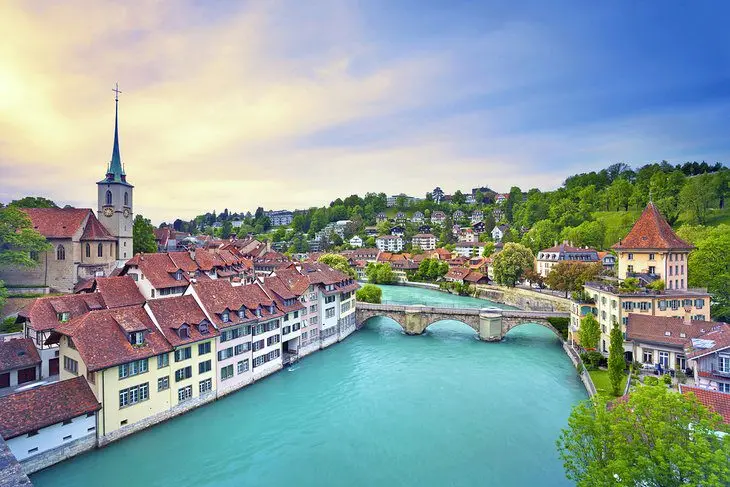
The Swiss capital has much to offer visitors, from swimming in the Aare River to walking around the medieval buildings in Old Town to seeing the many fountains (some over five centuries old) dotted throughout town.
The tower of the Gothic Cathedral of St. Vincent is the place to visit for amazing views over the city and the Bernese Oberland (mountains) in the distance – just climb the 344 steps to the top and bring your camera.
Bern is also home to an Einstein Museum – located inside the Bern Historical Museum – as well as a smaller museum inside the original apartment where Einstein lived and worked for many years. The historical clock tower, which dates back to the 13th century, and Switzerland’s second-biggest history museum are also great places to visit in Bern.
Shopping is always great in Bern, especially since instead of shopping malls, the locals shop in lauben, historical-looking arcades. There are also plenty of outdoor markets and in winter, lots of great Christmas markets. Just outside the city, there are plenty of hikes for all levels – from the rolling hills of the Gantrisch mountains to riverside paths crossing valleys and bridges.
Accommodation: Where to Stay in Bern
8. Chur
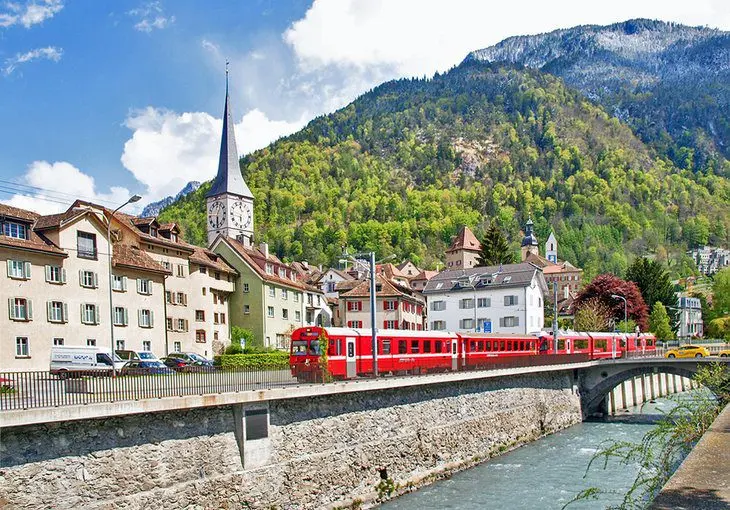
Dating back over 5,000 years, Chur is Switzerland’s oldest city. Its car-free Old Town Center is a great place to see some of that history, starting with the Saint Martin’s Church, the clock tower, and the Cathedral of Saint Mary of the Assumption.
Right behind the church, there’s the local Rätisches Museum, which chronicles the history of the area and includes archeological finds.
From late spring to fall, there are weekend markets in the main square, where you can find local fresh foods or rummage through the flea market stalls to find some vintage treasures.
Chur is surrounded by mountains, Alpine summer meadows, and some stunning views. From the center of Chur, you can hop on the cable car to the top of Brambrüesch, plus there are also hiking and biking trails departing straight from town.
Accommodation: Where to Stay in Chur
9. Montreux
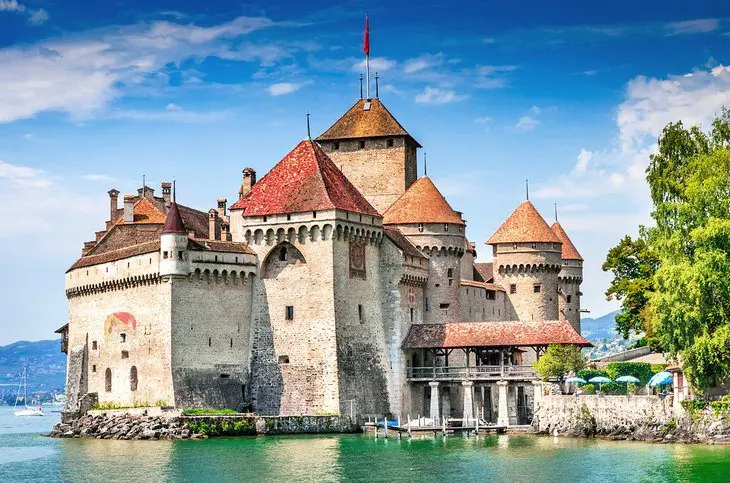
Montreux sits right on the banks of Lake Léman and against the backdrop of the Swiss Alps. A stunning resort with a promenade that connects to hiking trails, Montreux offers plenty of outdoor fun all year long.
One of the most beautiful hikes starts right near the Old Town center and takes you to the nearby village of Glion, which looks right over Montreux. The lake itself is great for swimming, canoeing, and sailing.
Montreux’s main attraction, however, is the 13th-century Chillon Castle, which sits on a rocky hill over the lake. During December, the castle hosts Montreux’s most famous Christmas market, a medieval feast where you can try local foods or browse through beautiful handicrafts.
Other great places to visit include the Charlie Chaplin Museum and the Queen Mountain Studios, the former musical studios of the legendary band Queen. The studio has been transformed into a museum of sorts, where you can see the original control room, old tapes, and even some of Freddie Mercury’s stage costumes.
From here, you can also catch the Chocolate Train, a first-class railway that connects Montreux with the Nestlé chocolate factory and makes a stop at a cheese factory in the town of Gruyères.
Accommodation: Where to Stay in Montreux
10. Fribourg
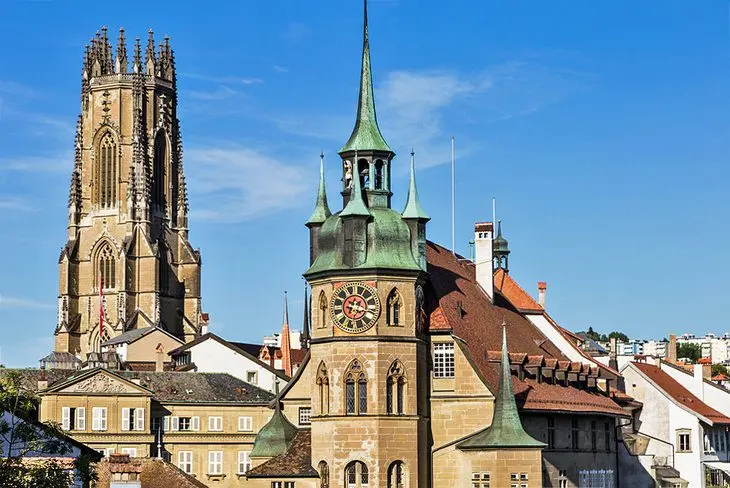
Fribourg is best known as a university town, but this medieval city has plenty of historical and medieval attractions waiting to be discovered.
A stroll through the picturesque Old Town will take you past the Cathedral of St. Nicholas, the working Hauterive Abbey, and the Baroque Loreto Chapel. There’s also a number of great little museums perfect for a rainy afternoon, including an Art History Museum and the Espace Jean Tinguely et Niki de Saint Phalle, dedicated to the work of 20th-century artists Jean Tinguely and Niki de Saint Phalle.
The city of Fribourg hosts many festivals throughout the year, such as the Fribourg Carnival in February, open-air music events on the beach during the summer, and special Désalpe celebrations in September/October, when the cows come down from the mountains to spend the winter indoors. There’s also a major St. Nicolas parade in early December and open-air cinemas during the warmer months.
Accommodation: Where to Stay in Fribourg
11. Lausanne
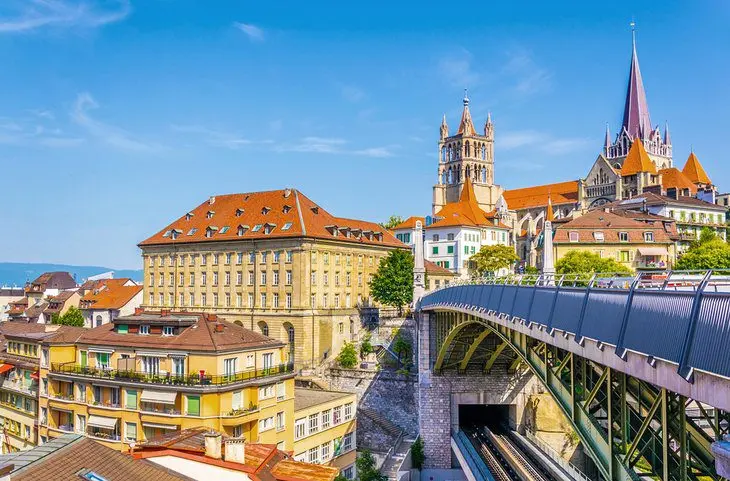
Lausanne sits right on Lake Geneva, and it’s surrounded by snow-topped mountains – a perfect combination for hikers, swimmers, and those wanting to spend time soaking in the views.
If that’s not enough, the city is also well-known for its chocolate and Swiss cheese, which you can taste at local restaurants and cafés.
In summer, the city hosts many free outdoor festivals, including the six-day-long Festival La Cité, which attracts musicians, dancers, and performers from all over the country.
Lausanne is home to the only Olympic Museum in Europe, which houses the world’s largest collection and archive of anything-Olympics. Even more unique is the Collection de l’Art Brut, home to art created by atypical artists, including patients from local psychiatric asylums, prisoners, and more.
Other must-see places in Lausanne include the Musée de l’Élysée, home to one of Europe’s most comprehensive photography collections, and the historical City Hall in the Old Town square.
Accommodation: Where to Stay in Lausanne
12. Lugano

Lugano sits against the border with Italy, right on Lake Lugano. Add to that the Lugano Prealps in the background offering plenty of outdoor activities, and it’s no surprise that the city has become one of the most popular summer destinations in Switzerland.
Monte Generoso is particularly popular because of the steep rack railway train that takes you to the summit for stunning views as far away as the Matterhorn.
Lake Lugano itself offers plenty of things to do as well, with boat tours and water taxis taking visitors to nearby villages (the lakeside village of Gandria is a favorite). The shoreline also offers about 50 “bathing spots” for safe entrance to the lake if you feel like swimming or just enjoying the warm waters – the lake has an average temperature between 19 and 24 degrees Celsius all summer long.
The town itself is home to many heritage sites, which include the Biblioteca, the Cathedral of San Lorenzo (rebuilt in the 15th century), the Museo Cantonale d’Arte of Lugano, and the Museo cantonale di storia naturale di Lugano. The museum dedicated to German poet and novelist Hermann Hesse is also worth a visit, and so is Piazza della Riforma, the heart of Old Town and the best place to find unique eateries, cafés, and boutique shops.
Accommodation: Where to Stay in Lugano










